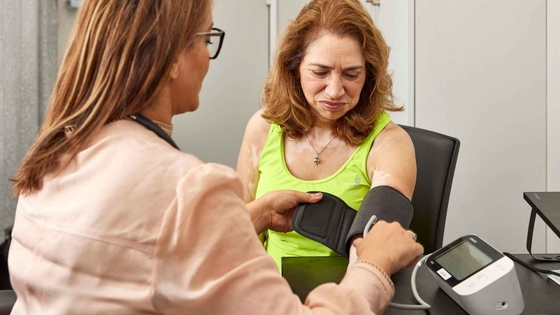
Cardiovascular disease risk factors and heart attack warning signs in women
Key takeaways
2 min read
- Chest pain is the most common heart attack symptom affecting women and men. Other non-chest pain symptoms includes jaw, shoulder or back pain, nausea or vomiting, dizziness, shortness of breath/difficulty breathing, indigestion or fatigue/tiredness.
- In addition to traditional cardiovascular disease risk factors, the risk of a heart attack or stroke can also be affected by women-specific risk factors.
- If you are a woman aged 45 and over (or 30 and over for Aboriginal and/or Torres Strait Islander women), speak to your GP about your risk of heart attack and stroke and have a Heart Health Check.
Cardiovascular disease risk factors and warning signs affecting women
The risk of cardiovascular disease in women changes throughout life’s course. It is important that everyone is aware of the risk factors and heart attack warning signs affecting women.
If you are a woman aged 45 and over (or 30 and over for Aboriginal and/or Torres Strait Islander women) speak to your GP about your risk of heart attack and stroke and have a Heart Health Check. Let your GP know if you have any of the risk factors mentioned below. Read more about the Heart Health Check.
If you are a healthcare professional, the below risk factors are important to consider when determining a woman’s absolute cardiovascular disease risk. Read more about the 2023 Guidelines for assessing and managing CVD risk.
Risk factors for cardiovascular disease in women
In addition to traditional cardiovascular disease risk factors, the risk of a heart attack or stroke may also be affected by women-specific risk factors. When talking to your doctor, it is important to let them know if you have ever been diagnosed with any of these conditions or risk factors.

Polycystic Ovary Syndrome (PCOS)
Polycystic ovary syndrome is the most common hormone-related disease affecting women of reproductive age. Women with polycystic ovary syndrome often have a lowered response to insulin (the hormone that regulates blood sugar levels). This can lead to obesity, high blood pressure, type 2 diabetes, and high cholesterol. All these factors increase the risk of cardiovascular disease.
Pregnancy complications
Some complications of pregnancy can increase a woman’s future risk of cardiovascular disease, including:
preeclampsia
having a low birth weight baby
having a baby born prematurely
increased blood pressure during pregnancy (gestational hypertension)
gestational diabetes.
If you experience any of these complications during pregnancy this means you should have annual monitoring of blood pressure and/or diabetes risk once the baby is born.
Read more about pregnancy and cardiovascular disease – for consumers
Read more about pregnancy and cardiovascular disease – for health professionals
Menopause and hormone therapy
As women transition into menopause, their risk of cardiovascular disease increases.
During menopause, women experience changes to their sex hormones, fat distribution and lipid metabolism and are at greater risk of high blood pressure, high blood sugar, excess body fat around the waist and abnormal cholesterol levels which can increase their risk of cardiovascular disease.
Women who enter menopause at age 45 or younger (early onset menopause) have a higher risk of cardiovascular disease.
Hormone replacement therapy (HRT), which includes oestrogen replacement, has been used for many years to treat short-term menopausal symptoms.
In some women, depending on their GP’s advice, HRT has also been used after menopause for those with osteoporosis.
There has been a lot of research into the effects of HRT on the development of heart disease. Based on this research the Heart Foundation does not recommend HRT in the treatment or prevention of heart disease. There is evidence to show the use of HRT amongst postmenopausal women around 60 years of age or older may increase the risk of cardiovascular disease.
Before commencing HRT, women should discuss the risks and benefits of the therapy with their GP.
People who identify as transgender (trans women) and use oestrogen hormone therapy have an increased risk of a heart attack compared to cis women (someone who identifies as a woman and was identified as female at birth is a cisgender woman). It is not clear whether trans men using hormone therapy are at increased risk of cardiovascular events.
Autoimmune disorders and their treatments
Autoimmune diseases such as lupus, multiple sclerosis and rheumatoid arthritis affect more women than men. These conditions, and some of their treatments, can worsen traditional risk factors for cardiovascular disease such as cholesterol and blood sugar levels.
Depression
Depression has been found to be an independent risk factor for coronary heart disease in women. Women with depression often have a poorer outcome after a heart attack.
Read more about mental health and cardiovascular disease – for consumers
Read more about mental health and cardiovascular disease – for health professionals
Oral contraception
Women who use combined oral contraceptives are at greater risk of a heart attack and blood clots than women who do not. For young women, oral contraceptives are usually safe. Women over 35 years of age who use combined oral contraceptives and who smoke are at particularly high risk of heart attack, stroke and blood clots.
Some treatments for cancers
Some treatments for cancers affecting the upper body, like radiotherapy and chemotherapy for breast cancer, can damage the heart. This can increase the risk of heart disease. Women who have had treatment for cancer should speak to their doctor about their heart disease risk.
Aboriginal and/or Torres Strait Islander women
Aboriginal and/or Torres Strait Islander women are almost twice as likely as non-Indigenous women to have cardiovascular disease.
Aboriginal and/or Torres Strait Islander women aged 30 and over should see their GP for a heart check. Find out more about First Nations heart health.
If you are a healthcare professional, read more about absolute cardiovascular disease risk assessment for Aboriginal and/or Torres Strait Islander peoples.
Heart attack warning signs
Know the full range of warning signs of a heart attack. Chest pain is the most common heart attack symptom affecting women and men.
Other non-chest pain symptoms including jaw, shoulder or back pain, nausea or vomiting, dizziness, shortness of breath/difficulty breathing, indigestion or fatigue/tiredness.
Women under 50 years of age present more often with non-chest pain symptoms of cardiovascular disease.

If you are experiencing unusual symptoms and think you might be having a heart attack, do not delay seeking help, call Triple Zero (000) right away.
If you are a healthcare professional, it is important to make sure your patients are aware of heart attack warning signs. Refer to the Acute Coronary Syndromes (ACS) clinical guidelines for more information.
References
1. Garcia M, Mulvagh Sharon L, Bairey Merz CN, Buring Julie E, Manson JoAnn E. Cardiovascular Disease in Women. Circulation Research. 2016;118(8):1273-93.10.1161/CIRCRESAHA.116.307547
2. Lee SK, Khambhati J, Varghese T, Stahl EP, Kumar S, Sandesara PB, et al. Comprehensive primary prevention of cardiovascular disease in women. Clinical cardiology. 2017;40(10):832-8.10.1002/clc.22767.
3. Geraghty L, Figtree GA, Schutte AE, Patel S, Woodward M, Arnott C. Cardiovascular disease in women: from pathophysiology to novel and emerging risk factors. Heart, Lung and Circulation. 2020
4. Roshanisefat H, Bahmanyar S, Hillert J, Olsson T, Montgomery S. Multiple sclerosis clinical course and cardiovascular disease risk–S wedish cohort study. European journal of neurology. 2014;21(11):1353-e88; Harbo HF, Gold R, Tintoré M. Sex and gender issues in multiple sclerosis. Therapeutic advances in neurological disorders. 2013;6(4):237-48
5. Mauvais-Jarvis F, Merz NB, Barnes PJ, Brinton RD, Carrero J-J, DeMeo DL, et al. Sex and gender: modifiers of health, disease, and medicine. The Lancet. 2020;396(10250):565-82.10.1016/S0140-6736(20)31561-0.
6. Okwuosa Tochi M, Morgans A, Rhee J-W, Reding Kerryn W, Maliski S, Plana J-C, et al. Impact of Hormonal Therapies for Treatment of Hormone-Dependent Cancers (Breast and Prostate) on the Cardiovascular System: Effects and Modifications: A Scientific Statement From the American Heart Association. Circulation: Genomic and Precision Medicine.0(0):HCG.0000000000000082.10.1161/HCG.0000000000000082.
7. Connelly Paul J, Marie Freel E, Perry C, Ewan J, Touyz Rhian M, Currie G, et al. Gender-Affirming Hormone Therapy, Vascular Health and Cardiovascular Disease in Transgender Adults. Hypertension. 2019;74(6):1266-74.10.1161/HYPERTENSIONAHA.119.13080; Streed CG, Jr., Harfouch O, Marvel F, Blumenthal RS, Martin SS, Mukherjee M. Cardiovascular Disease Among Transgender Adults Receiving Hormone Therapy: A Narrative Review. (1539-3704 (Electronic)); Nota Nienke M, Wiepjes Chantal M, de Blok Christel JM, Gooren Louis JG, Kreukels Baudewijntje PC, den Heijer M. Occurrence of Acute Cardiovascular Events in Transgender Individuals Receiving Hormone Therapy. Circulation. 2019;139(11):1461-2.10.1161/CIRCULATIONAHA.118.038584.
8. Patel SS, Truong U, King M, Ferland A, Moreau KL, Dorosz J, et al. Obese adolescents with polycystic ovarian syndrome have elevated cardiovascular disease risk markers. Vascular Medicine. 2017;22(2):85-95
9. O’Kelly AC, Michos ED, Shufelt CL, et al. Pregnancy and Reproductive Risk Factors for Cardiovascular Disease in Women. Circulation Research. 2022;130(4):652-672. doi:doi:10.1161/CIRCRESAHA.121.319895
10. McBride KF, Rolleston A, Grey C, Howard NJ, Paquet C, Brown A. Māori, Pacific, Aboriginal and Torres Strait Islander Women's Cardiovascular Health: Where Are the Opportunities to Make a Real Difference? Heart Lung Circ. Jan 2021;30(1):52-58. doi:10.1016/j.hlc.2020.06.029
11. Rajendran A, Minhas A, Kazzi B et al. Sex-specific differences in cardiovascular risk factors and implications for cardiovascular disease prevention in women. Atherosclerosis. 2023;384(117269). doi: 10.1016/j.atherosclerosis.2023.117269
You might also be interested in...

Women and heart disease
Almost every hour of every day an Australian woman dies of coronary heart disease. On average that equates to 20 women a day.1

Women's heart stories
Heart disease affects women of all ages. Watch real stories from women and their journeys with heart health, recovery, and the importance of early detection.

Five reasons to focus on women’s heart health
Why is the Heart Foundation raising awareness about women's heart health? Learn about some of the unique challenges faced by women.
Last updated23 September 2024
Last reviewed17 February 2024